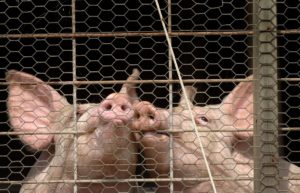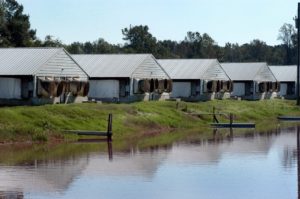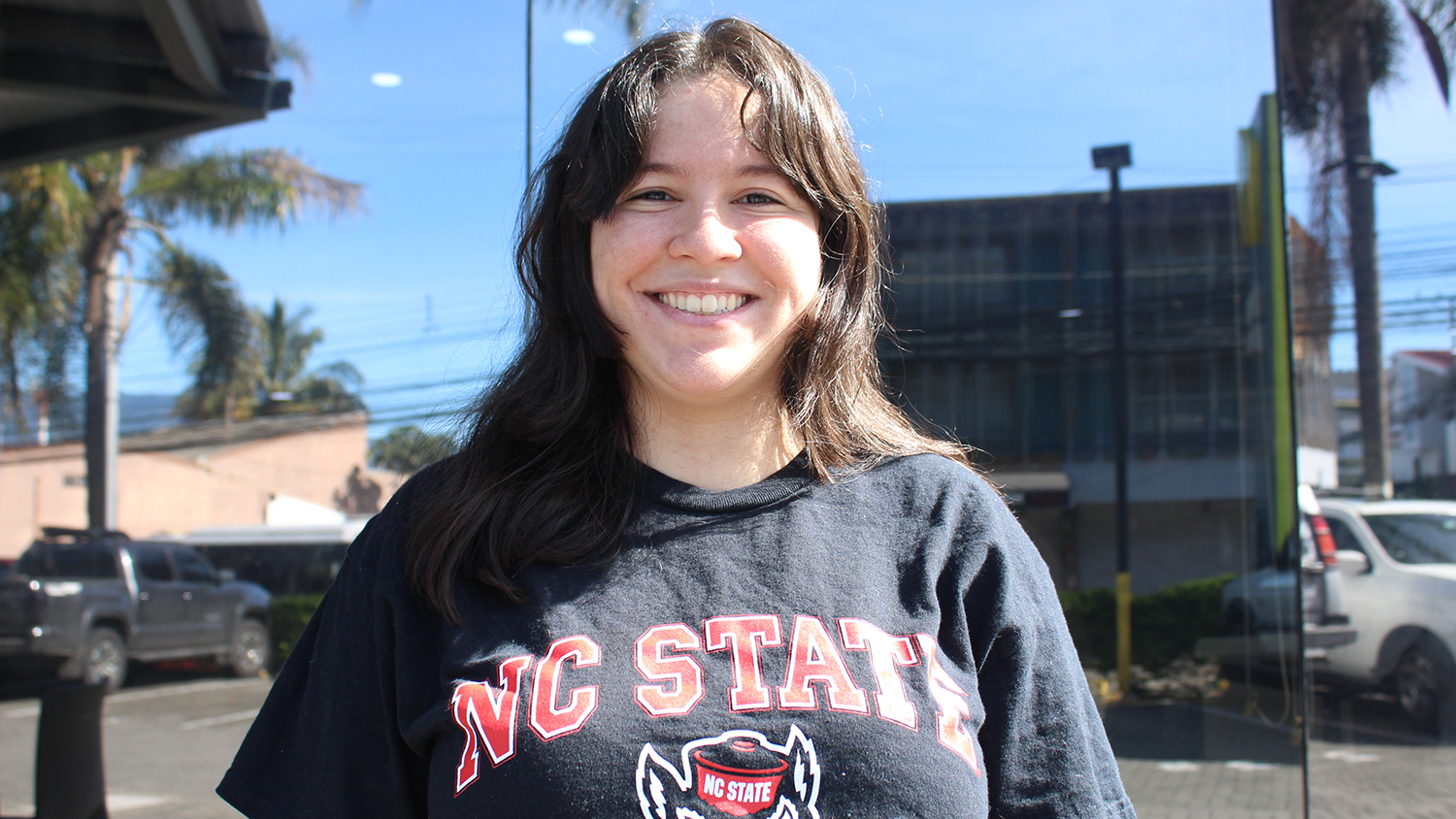Brianna Hess Massie

The Determination of Brianna Hess Massie to Contribute to Hog Farming Success
Here are a few things NC State University doctoral student Briana Hess Massie knows:
She knows a good deal about the myriad environmental issues of commercial hog operations and the challenges they pose. Massie is well-versed in waste technologies that might make for a more
pleasant scenario for hog farming and its environmental impact.
With an organic solution in hand, one inexpensively and easily implemented, farmers could revolutionize how hog wastes are handled, and, as a true bonus, also change how the operations smell.
Massie had prior research experience analyzing peanut skins and hull wastes. She now imagines a future wherein something abundant and cheap, much like peanut hulls or egg shells, might be used to mitigate a smelly problem and remove heavy metals from hog wastes.
Her nose for a solution was developed during early graduate studies at NC State University. The doctoral student, now completing her degree in bio-engineering, also has studied chemistry and food science. Massie trained as a sensory panelist while completing her master’s degree in food science, so she has an objective sense of smell that serves her well in her present work.
“I was part of the U.S. Department of Agriculture market quality and handling research unit,” she explains. “In food science, they have a cucumber, sweet potato and peanut lab, and part of your duties are to do a sensory lab.” The experience trained Massie in objectifying tastes and smells, among other things.
However, after her graduate work, she segued into civil engineering and waste technologies due to the work of NC State University’s Praveen Kolar, a bio-engineering professor. Massie’s
work was called to his attention, and he was immediately interested.
“I had a two-part master’s thesis. The first part was removal of arsenic and cadmium from hog waste, and the other part was making a food product out of peanut skins into a polyphenol
nutraceutical. Often, peanuts are grown where cotton is grown, and the pesticide used on cotton contained arsenic, so, it is still in the soil. In the peanut skins there is arsenic. And, we
are learning that plants do uptake it, so arsenic is more of a concern.”
Massie saw the peanut wastes were valuable and useful. She wanted to put those unused skins and hulls to use. She determined that she wanted to work in the area of adsorption,
and so she reached out to various departments, including engineering.
“I started emailing departments. Professor Praveen Kolar was interested. He wanted to look at the issue of biomass and adsorption.” That, Massie explained, became her main research
focus.
Massie entered doctoral studies in biological and agricultural engineering and began working under Kolar. Kolar had a keen interest in applied technologies. He has done graduate research in India, at Louisiana State University and at the University of Georgia prior to arriving at NC State. He has worked in aquaculture in India, his native country, with sustainable shrimp farming. At LSU, he earned a second master’s degree while researching sustainable oyster farming and processing.
Kolar came to NC State in 2009 after completing a doctorate at UGA, where he had worked with aquaculture and biological filtration with nitrogen.
At NC State, Kolar’s work centered upon biomass and green technologies, and the wastes generated by food harvesting and production. He studied ways to take wastes such as shrimp shells as catalysts for converting oil into biodiesel. He was also examining ways to alter the poultry and hog farming industries’ environmental impact, alleviating the odors inherent in both operations.
Massie explains that she left chemistry behind because she wanted to go into an applied science versus one that was theoretical. Here in Kolar’s lab, Massie found a way to put her background into action.
THE ROAD TO THE FLATLANDS
How did the young researcher’s background and interests culminate in this work and at this place?
Massie, who grew up in Appalachia, is from the hill country of Virginia and new to the flatlands, she says. As far as geography goes, she still prefers the hills to the Triangle, and when she has the rare opportunity to go hiking, she misses the mountains of her youth.
“I grew up in Russell County, Va., near Bristol,” explains Massie. She was one of three children and her grandfather was once a coal miner. At the time, there were better workplace regulations within the industry, and coal was thriving, she says. And her Appalachian family did not discount education. “I had the advice to do good and read books.”
Her mother was an educator who instilled a love of learning. “My mother has two master’s degrees. And, my mom was the first in her family to go get a four-year college degree.” Massie adds shyly, “But I’m the first to earn a PhD.” Massie’s father also urged her to get an education or else “face a life of dead-end ‘grunt jobs,’” she says.
She liked science. Yet there were no scientists in Massie’s family. In fact, her mother “doesn’t really like science. She doesn’t like for me to talk about it.”
Today, Massie’s doctoral work concerns swine lagoons.
“Brianna is focusing on adsorbents for removing odors and heavy metals from lagoon water,” explains Kolar.
While the numbers of actual hog farms in operation are lower, the numbers of hogs per herd has grown substantially. Fewer farms handled much larger herds.

In 2009, N.C. hog farmers raised an average of 8,389 hogs. Smaller farming operations had become exponentially larger, more like enclosed factories, relying upon clay-lined, open lagoons for disposal and containment of excrement and wastes. Unlike hog operations in other states that use pits for waste management, N.C. hog farms still employed lagoons.
By 2012, the USDA’s 2012 agricultural census reported that Duplin County ranked first in the nation in hog and pig sales. Sales of $614 million that year represented 3 percent of the national total. The industry was geographically concentrated, largely confined to contiguous counties within the state’s coastal plain. One mapping service observed, “This cluster of counties is often referred to as ‘Swine Alley.’” The location posed other environmental concerns—born of volume, waste management issues were of a large-scale.
“There are 2,400-ish hog farms here, and each will have a lagoon in N.C.,” says Massie. “In N.C., we have 8 or 9 million hogs at a time. North Carolina accounts for 80 percent of southeastern U.S. hog production.”
This means that N.C. pork production ranks second only to Iowa. The issue of wastes, too, is a matter of scale, as N.C. farms morphed from farms with 945 or fewer heads of hogs in 1992, into fewer, but much larger, commercial operations in this century.
A 1997 moratorium on building hog farms then led to an overall decline in hog farms. Older, grandfathered lagoons were not clay lined, but newer ones were. The older lagoons were of more concern.
“When they first started building them, they were unlined, and they seeped into water supply,” Massie says. There was another problem at work, delivered by Mother Nature. Storm patterns were changing in both intensity and impact. An increase in what were once considered “500-year storms” meant that existing lagoons within coastal areas were even more problematic.
During hurricane events and tropical storms, berms were threatened. The breach of lagoon berms could cause the contained wastes to spill or wash out. The wastes could in turn cause fish kills and have other impact. Contaminants in thewastes could enter the water supply. The contaminants within the lagoons included bacteria such as e-coli and high levels of nitrates, copper and arsenic.
Farmers recycled lagoon wastes, using them as fertilizers. Typically, the wastes are sprayed in nearby fields.
“The way they dispose of the treated liquid in the swine lagoon is, waste comes in, the bacteria breaks it down, and the material stays in the lagoon for an amount of time to allow the pathogens to be reduced. But, there are nutrients in the treated wastes, so they spray this on crops,” Massie says.
There are very specific regulations guiding the use of the treated wastes, she adds. Nonetheless, other issues arise when potentially toxic levels of nutrients concentrate in the soil. Massie’s research specifically tackles a subsection of that concentration: Her focus is copper.
How does copper get into the wastes? “Copper gets built up in the (waste) water because copper actually comes from feeding the swine this in the food supplements. These metals are good at controlling enteric pathogens in the gut, and the pigs then grow better.”
And so, excess copper is excreted as waste into the lagoon water. When waste water is sprayed onto crops, the copper can reach a concentration within the fertilized plants that hampers growth.
“Until you get reduced (plant) growth that is visually observed, the nutrients are sitting in the soil to wash away.” When copper enters creeks and rivers, it has further repercussions. Massie explains, “Small vertebrates are affected. Fish will not grow as well and will have offspring with defects.”
AN ENVIRONMENTALLY SUPERIOR TECHNOLOGY THAT COSTS PEANUTS
In 2014, NC State University professor Praveen Kolar was working with research concerning swine lagoons and biogas. He had long worked to develop a catalytic process that could remove a large percentage of the smell generated by rendering plants. Now, his work focused upon methods to remove the stench from pig wastes and to find ways of using waste materials for positive purposes.
The university had been working with hog waste management in earnest since the year 2000, when the “Smithfield Agreement” funded environmentally superior technologies, or ESTs, to assist better hog waste practices. NC State University was charged by state government with determining those technologies. Kolar’s work in biological and agricultural engineering dovetailed with those technologies.
This was not simple work from an economic stance either. ESTs were needed; yet costs to enact them were a considerable hurdle. A problem of scale doesn’t explain all issues facing ESTs.

“Swine lagoons are huge,” Massie says. Plus, there were definite financial concerns. The farmers usually owned the facilities, but not the pigs. They are paid to raise them, bringing the pigs up to market weight. It falls to the farmer to shoulder the costs and risks of the operations and lagoons, not the owner of the herd.
“Most farmers are operating at small profit margins,” says Massie. “It’s hard for them to invest in much technology, because just opening up a swine lagoon can cost $50-60,000.”
Existing swine lagoons were grandfathered in since regulations were enacted with the intention to protect surrounding lands. A percentage of the grandfathered lagoons still remain in use.
CHEAP AND EASY SOLUTIONS
“NC State wanted to find inexpensive, simple ways to offset how wastes were treated. My focus was trying to find a way that was cheap-to-free, would work with existing swine lagoons, but would not be heavily technical,” explains Massie.
Kolar and other researchers have tested activated carbon in mitigating wastes. Yet there is an even cheaper option, Massie believes.
Massie thinks adsorption is a better solution in dealing with hog wastes. Adsorption refers to adhesion of molecules to the surfaces of solids or liquids they contact. “We think adsorption is the best way to do it. I added the component that the best thing to do is to use waste products that are already there.”
“You can get a lot of bulk products like peanut shells coming out of the food industry. You can buy peanut shells for pennies a ton, and so transportation is also cheap. So you put the adsorbent in the swine lagoon. Then transport the adsorbent somewhere else rather than in the field where the sprayed copper would have gone. The main problem is, it is being sprayed and concentrated in a concentrated area, like Duplin County, where most of the hog farms are. It’s not super toxic. Again, it’s just a matter of scale.”
A SIMPLE MODEL WITH A COMPLEX SOLUTION
Massie’s model is simple. It mitigates harmful levels of copper and by-products. She has proven that eggshells will take copper out of effluent in swine lagoons. “Now, we’re looking at ways to improve that efficiency. We’re on the point of proving this is something you can do reliably and cheaply, and hit the sweet spot between using a cheap material and not having to truck in a load every single day.” She feels close to a working model.
“If I had control, the final system would look like, say, materials like egg shells and bones that contain calcium carbonate and minerals. You have very reduced copper in the lagoon, so I’d like to pump the lagoon effluent out and aerate it in a secondary pond and filter it through a bed of adsorbent. So that, when the liquid comes through, the dissolved copper would adhere to the surface and the adsorbent. Then the levels would be lower and could safely go on the fields as sprayed fertilizer.”
Who will pay for the costs of an adsorbent, no matter if it’s only peanuts? “Most of the large pork producers own the animals and farm out the work of raising these animals to the farmer,” she explains. The farmers’ margins are already small, and the cost of adding new technologies is high.
“Yes, there are many very large overarching problems with hog farms,” notes Massie, “but you could say the same thing for communities located near large industrial complexes.” In the final analysis, it is a structural issue. Heretofore, many operators could not afford to upgrade waste treatment processes.
Massie considers the impact of their research, even if there is a cost to the farmer. “Best case: you extend the sustainability of the hog farming system, so you’re keeping them in business, therefore lessening the watershed effects and keeping the costs low and extending the industry,” says Massie. “And, it mitigates the environmental impact. Operationally, it is pretty well controlled as far as the watershed safety; but, lagging behind, concerning the compounds that are building up there.”
She considers the down side. “Worst case: the adsorbents don’t work,” she says. “It’s pretty much a question of the scale, which is enormous. Human waste is treated very well. But it’s expensive. You don’t have that money to put into the agricultural sector. We are never going to get to the point that agriculture is going to be zero impact. And, the technology is often too expensive.”
Massie says her research is still on bench scale; it will probably be tested in reality after she completes her doctorate this year.
There’s yet another plus: “With adsorption, you can make it happen quickly.” And, luckily, there is little red tape with getting adsorption techniques approved.
Massie is optimistic. “It’s not so long to get from bench shop to implementation. I guess the blue sky view is my technology will be a safety gap before a truly viable technology.”
Read more from the Graduate School’s Think Magazine.
Learn about graduate programs in bio and ag engineering.
Download this article as a PDF.
- Categories:


